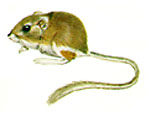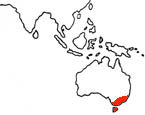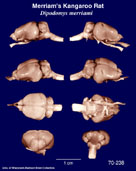|
Merriam's Kangaroo
Rat
(Dipodomys merriami) #70-238 |
||||
|
|
Physical
characteristics and distribution
|
|
The name derives from their bipedal form (they hop like tiny kangaroos) but the resemblance is purely visual: kangaroo rats and kangaroos are only distantly related, as both are mammals. Twenty one species are currently recognized. Size varies from 100 to 200 mm, with a tail of equal or slightly greater length; weight can be anywhere between 35 and 180 grams. The most distinctive feature of the D. merriami is their very long, hind legs. Like the jerboas of African and Asian deserts and the hopping mice of outback Australia, D. merriami have highly developed hind legs, live in deep burrows which shelter them from the worst of the desert heat, and rarely drink water. Instead, they have a highly water-efficient metabolisim (their kidneys are at least four times more efficient than those of humans), and manufacture water by chemical breakdown of their food. Their diet includes seeds, leaves, stems, buds, some fruit, and insects. D. merriami use their burrows and buried caches nearby to store food against the possibility of bad seasons. D. merriami are found in arid and semi-arid areas which retain some grass or other vegetation, in NW Nevada and NE California to Texas (USA), south to Baja California Sur, N Sinaloa, and the Mexican Plateau to San Luis Potosi (Mexico). |
|
Description
of the brain
|
|
Animal
source and preparation
|
|
All
specimens collected followed the same preparation
and histological procedure.
|
Other Related Resources (websites and publications)
List of Specimens | Explore Collections | Brain Sections | Brain Evolution | Brain Development | Brain Circuitry | Brain Functions | Location and Use | Related Web Sites | Contact Us | Search MSU Database | Personnel | Home



